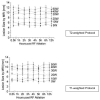Characterization of acute and subacute radiofrequency ablation lesions with nonenhanced magnetic resonance imaging
- PMID: 17275759
- PMCID: PMC1852460
- DOI: 10.1016/j.hrthm.2006.10.019
Characterization of acute and subacute radiofrequency ablation lesions with nonenhanced magnetic resonance imaging
Abstract
Background: Magnetic resonance imaging (MRI) has the potential to visualize radiofrequency (RF) ablations, which have become the preferred strategy for treatment of many arrhythmias. However, MRI patterns after RF ablation have not been well investigated.
Objective: The purpose of this study was to define the characteristic appearance and the effect of time and energy on noncontrast-enhanced MRI of RF ablation.
Methods: Using a power-controlled, cooled-tip ablation system, RF ablation lesions (5-50 W for 45 seconds) were created on the right ventricular epicardium in 10 mongrel dogs. T1- and T2-weighted MR images were obtained during 12-hour follow-up and compared with gross anatomy and histopathology.
Results: Lesions were successfully visualized with T2- and T1-weighted images 30 minutes to 12 hours after RF ablation. T2 images were more consistent and displayed a characteristic elliptical, high-signal core (contrast-to-noise-ratio [CNR] = 18.9 +/- 8.4) with a surrounding 0.5-mm low-intensity rim that on histopathology corresponded to the central tissue necrosis and the transition zone, respectively. T1 images showed a less remarked increase in signal intensity (CNR = 9.6 +/- 7.4) without a surrounding rim. Lesion size and appearance were well defined and unchanged during the 12-hour follow-up (analysis of variance). CNR was independent of applied RF energy and allowed accurate assessment of RF ablation at all time points (r = 0.87 and r = 0.83 for T2 and T1 images, respectively). Transmural lesions, interlesional gaps, and intralesional pathology could be reliably predicted in >90%.
Conclusion: Noncontrast-enhanced MRI allows accurate assessment of RF ablation and its intralesional pathology during 12-hour follow-up. This finding confirms a possible role of MRI in guiding and evaluating RF application during electrophysiologic ablation procedures.
Conflict of interest statement
Conflicts-of-Interest/Financial Disclosures: None
Figures







Comment in
-
Nonenhanced magnetic resonance imaging for characterization of acute and subacute radiofrequency ablation lesions.Heart Rhythm. 2007 Feb;4(2):215-7. doi: 10.1016/j.hrthm.2006.11.013. Epub 2006 Nov 17. Heart Rhythm. 2007. PMID: 17275760 No abstract available.
References
-
- Aso M, Yui Y, Kakishita M. Effects of thermal denaturation on the longitudinal relaxation time (T1) of water protons in protein solutions: study of the factors determining the T1 of water protons. Magn ResonImaging. 1988;6:17–25. - PubMed
-
- Dromain C, de Baere T, Elias D, Kuoch V, Ducreux M, Boige V, Petrow P, Roche A, Sigal R. Hepatic tumors treated with percutaneous radiofrequency ablation: CT and MR imaging follow-up. Radiology. 2002;223:255–262. - PubMed
-
- Farahani K, Saxton RE, Yoon HC, De Salles AA, Black KL, Lufkin RB. MRI of thermally denatured blood: methemoglobin formation and relaxation effects. Magn ResonImaging. 1999;17:1489–1494. - PubMed
-
- Feld GK, Fleck RP, Chen PS, Boyce K, Bahnson TD, Stein JB, Calisi CM, Ibarra M. Radiofrequency catheter ablation for the treatment of human type 1 atrial flutter. Identification of a critical zone in the reentrant circuit by endocardial mapping techniques. Circulation. 1992;86:1233–1240. - PubMed
Publication types
MeSH terms
Grants and funding
LinkOut - more resources
Full Text Sources
Other Literature Sources
Medical

